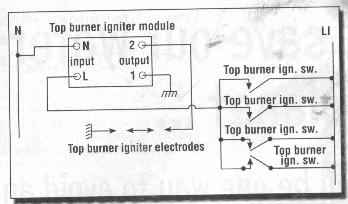
|
|
| Podcast |
| Live Help |
| Repairware |
| Hotline |
| Repair Forum |
| Beer Fund |
| Cool Stuff |
| Home |
|
|
| Buy Appliance Parts Here! |
| Search the vast repository of wisdom at Fixitnow.com: |

|
Did you know that 90% of the spark modules in gas ranges and cooktops that are replaced are perfectly good? A statistic like that tells me that this topic is screaming for an Appliantology article. This Appliantology article explains the basic principles of operations of the spark ignition system and how to troubleshoot 'em. So, grab a beer and let's rock!
A typical spark module shown below. The N terminal on the input side must be wired directly to line neutral. The L terminal is the 120v supply which is supplied to the module through any one of surface switches. The output terminals each connect to two burner ignitors; so the module shown below is designed to handle four surface burners--the most common configuration. Modules came in all different sizes and configurations, depending on the range.

 Now, here's what's supposed to happen--refer to the wiring diagram show here and sing along. You turn on one of the surface switches to fire up a burner. When you turn the switch to the "ignite" position, you complete the circuit, through the switch, to the module. This fires up the coils to produce a 15,000 VDC spark to the burners. The path this high voltage spark takes is through the ignitor wires to the ignitor (the ceramic electrode thingy up at the burner) where the spark jumps to the burner base. The voltage then passes through the burner to the grounding strap, through the chassis and then to the grounding strap of its partner burner (remember, each output from the module is tied to two burners), to its burner base and then jumps from the burner base to the ignitor (that's right from the base to the ignitor), passing back through the ignitor wire, to the coil, thus completing the spark circuit. The principle behind this is that the spark module must sense the electrical pulse. If it doesn't, well, your stove won't fire up right and that's why you're reading this article.
Now, here's what's supposed to happen--refer to the wiring diagram show here and sing along. You turn on one of the surface switches to fire up a burner. When you turn the switch to the "ignite" position, you complete the circuit, through the switch, to the module. This fires up the coils to produce a 15,000 VDC spark to the burners. The path this high voltage spark takes is through the ignitor wires to the ignitor (the ceramic electrode thingy up at the burner) where the spark jumps to the burner base. The voltage then passes through the burner to the grounding strap, through the chassis and then to the grounding strap of its partner burner (remember, each output from the module is tied to two burners), to its burner base and then jumps from the burner base to the ignitor (that's right from the base to the ignitor), passing back through the ignitor wire, to the coil, thus completing the spark circuit. The principle behind this is that the spark module must sense the electrical pulse. If it doesn't, well, your stove won't fire up right and that's why you're reading this article.
When you're having trouble getting your stove burners to ignite, usually it takes the form of one of the three types of problems:
Let's take 'em one at a time and list the things you need to look at.
First thing to do in this case are the following observation checks which do not require any tools, instruments, or taking anything apart.
These following two checks are done by physical inspection "under the hood":

This is usually a bad spark module. Verify that the outlet polarity is correct before you change the module. The following flow chart can give further guidance on the troubleshooting erratic spark problems:

First, verify that the spark module is getting the 120v on terminal L when you turn on any one of the surface switches. If it is, and still no spark, that module is DOA--replace it.
Well, there it is, the web's most definitive gas stove electric ignition troubleshooting guide. If this was helpful to you, your donations to The United Samurai Beer FundŽ are much appreciated. Cheers!
To learn more about your range/stove/oven, or to order parts, click here.

|
Back to Oven Repair Manuals |
Podcast | Live Help | Buy Parts | Repair Forum | Beer Fund | Cool Stuff | Home
 Your Appliance Guru:
Your Appliance Guru:
Samurai Appliance Repair Man
URL: http://www.fixitnow.com
© copyright 1997-2004 Live It Up LLC
No part of this website may be reproduced or copied without the prior written permission of Live It Up LLC.